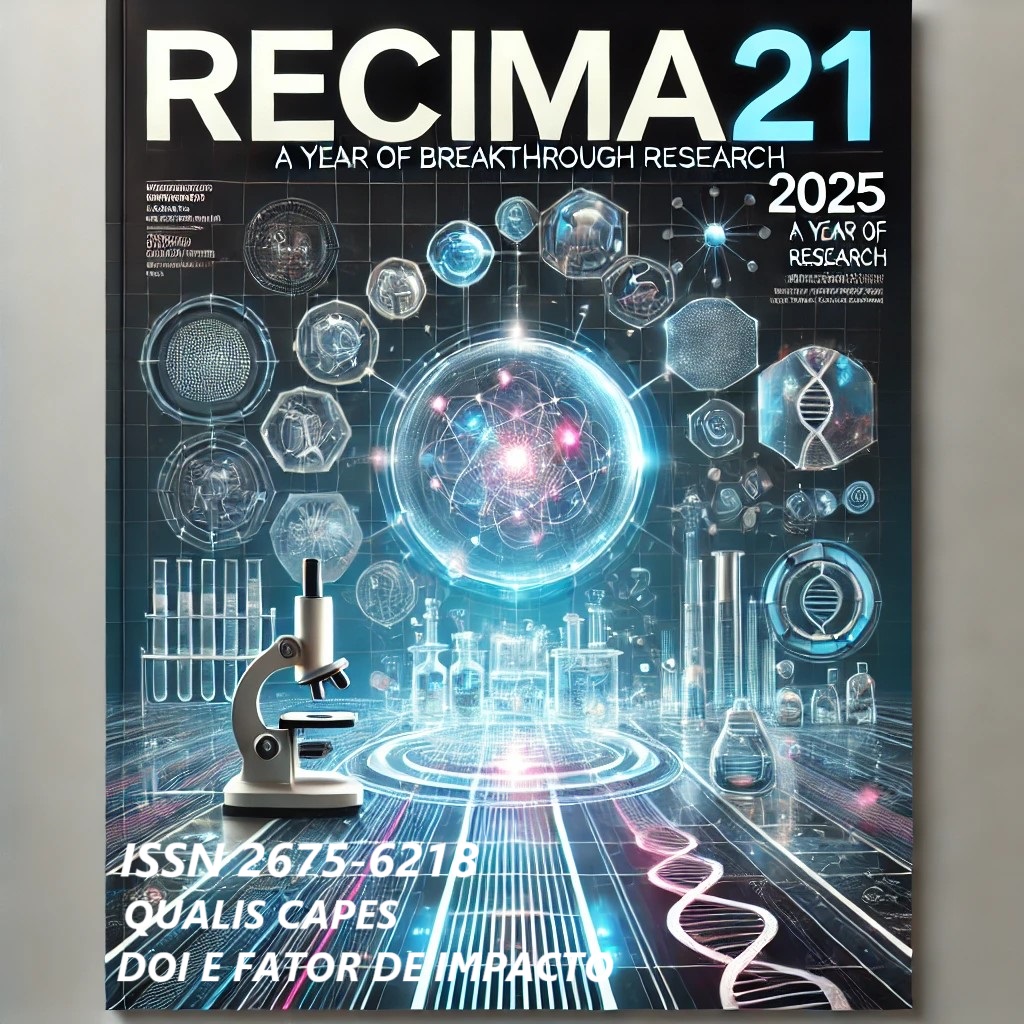ENTEROBÍASE: ASPECTOS ATUAIS
DOI:
https://doi.org/10.47820/recima21.v6i8.6678Palavras-chave:
Enterobíase, Helmintíase, Enterobius vermicularisResumo
A enterobíase (oxiuríase) é uma parasitose intestinal causada pelo nematódeo Enterobius vermicularis, com relevância clínica tanto por suas manifestações intestinais quanto pela associação com infecções do trato urinário. Este manuscrito aborda os aspectos epidemiológicos, clínicos e terapêuticos da infecção, que apresenta prevalência de 5,9% no Brasil, influenciada por condições socioambientais. O quadro clínico caracteriza-se por prurido anal e, em meninas, infecções urinárias recorrentes. Apesar do curso geralmente benigno e da alta eficácia terapêutica, o conhecimento amplo de sua epidemiologia, manifestações atípicas e estratégias de controle é fundamental para o manejo adequado por profissionais de saúde, especialmente em populações pediátricas e ambientes coletivos.
Downloads
Referências
ABDOLRASOULI, A.; ROUSHAN, A.; HART, J. Enterobius vermicularis infection of female genital tract. Sexually Transmitted Infections, v. 89, n. 1, p. 37, 2013. DOI: https://doi.org/10.1136/sextrans-2011-050425. DOI: https://doi.org/10.1136/sextrans-2011-050425
ARAÚJO, J. C. B. Enterobíse. In: FOCACCIA, R. (ed). Veronesi-Focaccia: Tratado de infectologia. 5. ed. rev. e atual. São Paulo: Editora Atheneu, 2015. p. 2011-2014.
BRASIL. Ministério da Saúde. Doenças Infecciosas e parasitárias: Guia de bolso. 8. ed. Brasília: Ministério da Saúde, 2010.
CIMERMAN, S.; CIMERMAN, B. Enterobíase. Revista Panamericana de Infectologia, v. 7, n. 3, p. 27-30, 2005.
COCIANCIC, P.; RINALDI, L.; ZONTA, M. L.; NAVONE, G. T. Formalin-ethyl acetate concentration, FLOTAC Pellet and anal swab techniques for the diagnosis of intestinal parasites. Parasitology Research, v. 117, n. 11, p. 3567-3573, 2018. DOI: https://doi.org/10.1007/s00436-018-6054-9. DOI: https://doi.org/10.1007/s00436-018-6054-9
COELHO, L. M. P. S.; SOBRINHO, T. A.; OLIVEIRA, S. M.; IKEGAMI, M. T.; YOSHIZUMI, A. M.; NAKAMOTO, A. Y. K. et al. Ovos e larvas de helmintos nos sanitários de pré-escolas municipais de Sorocaba, SP e suas freqüências nas fezes das crianças. Revista da Sociedade Brasileira de Medicina Tropical, v. 32, n. 6, p. 647-652, 1999. DOI: https://doi.org/10.1590/S0037-86821999000600006. DOI: https://doi.org/10.1590/S0037-86821999000600006
COFFENG, L. E.; STOLK, W. A.; DE VLAS, S. J. Predicting the risk and speed of drug resistance emerging in soil-transmitted helminths during preventive chemotherapy. Nature Communications, v. 15, n. 1, p. 1099, 2024. DOI: https://doi.org/10.1038/s41467-024-45027-2. DOI: https://doi.org/10.1038/s41467-024-45027-2
DE KOSTHA, Y. B. N. S.; PATHIRANA, S.; HANDUNNETTI, S.; GUNAWARDENA, S. Characterization of antigens of Enterobius vermicularis (pinworm) eggs. Scientific Reports, v. 12, n. 1, p. 14414, 2022. DOI: https://doi.org/10.1038/s41598-022-18303-8. DOI: https://doi.org/10.1038/s41598-022-18303-8
DENT, A. E.; KAZURA, J. W. Enterobíase (Enterobius vermicularis). In: KLIEDMAN, R. M.; STANTON, B. F.; ST GEME, J. W.; SCHOR, N. F. (Org.). Nelson Tratado de Pediatria. 20 ed. Rio de Janeiro: Elsevier, 2018.
EGWUNYENGA, A. O.; AJAYI, J. A.; NMORSI, O. P.; DUHLINSKA-POPOVA, D. D. Plasmodium/intestinal helminth co-infections among pregnant Nigerian women. Memorias do Instituto Oswaldo Cruz, v. 96, n. 8, p. 1055-1059, 2001. DOI: https://doi.org/10.1590/s0074-02762001000800005. DOI: https://doi.org/10.1590/S0074-02762001000800005
GIALAMAS, E.; PAPAVRAMIDIS, T.; MICHALOPOULOS, N.; KARAYANNOPOULOU, G.; CHEVA, A.; VASILAKI, O. et al. Enterobius vermicularis: a rare cause of appendicitis. Türkiye Parazitoloji Derneği, v. 36, n. 1, p. 37-40, 2012. DOI: https://doi.org/10.5152/tpd.2012.09. DOI: https://doi.org/10.5152/tpd.2012.09
GOMES, A. P.; MIGUEL, P. S. B.; SANTANA, L. A.; ALVAREZ-PEREZ, M. C.; SIQUEIRA-BATISTA, R. Doenças infecciosas na prática clínica. Rio de Janeiro: Thieme Revinter, 2024.
GRYSCHEK, R. C. B.; CHIEFFI, P. P.; PAULA, F. M. Parasitoses intestinais. In: MARTINS, M. A.; CARRILHO, F. J.; ALVES, V. A. F.; CASTILHO, E. A.; CERRI, G. G. (Org.). Clínica Médica: alergia e imunologia clínica, doenças da pele, doenças infecciosas. 2. ed. ampl. e rev. vol. 7. Barueri: Manole, 2016. p. 697-705.
HSIAO, Y. C.; WANG, J. H.; CHU, C. H.; CHANG, Y. H.; CHANG, Y. C.; JAN, R. H. Is pinworm infection still a public health concern among children in resource-rich regions? Trends in pinworm infection prevalence and associated factors among children in Hualien County, Taiwan: a retrospective cross-sectional study. BMC Public Health, v. 22, n. 1, p. 2200, 2022. DOI: https://doi.org/10.1186/s12889-022-14641-4. DOI: https://doi.org/10.1186/s12889-022-14641-4
IDRIS, O. A.; WINTOLA, O. A.; AFOLAYAN, A. J. Helminthiases; prevalence, transmission, host-parasite interactions, resistance to common synthetic drugs and treatment. Heliyon, v. 5, n. 1, p. e01161, 2019. DOI: https://doi.org/10.1016/j.heliyon.2019.e01161. DOI: https://doi.org/10.1016/j.heliyon.2019.e01161
JANTHU, P.; DUMIDAE, A.; SUBKRASAE, C.; ARDPAIRIN, J.; NATEEWORANART, S.; THANWISAI, A. et al. Prevalence and genetic analysis of Enterobius vermicularis in schoolchildren in lower northern Thailand. Parasitology Research, v. 121, n. 10, p. 2955-2965, 2022. DOI: https://doi.org/10.1007/s00436-022-07626-0. DOI: https://doi.org/10.1007/s00436-022-07626-0
KASHYAP, B.; SAMANTRAY, J. C.; KUMAR, S.; JHAMB, R.; SINGH, A. K.; KAUR, I. R. Recurrent paediatric pinworm infection of the vagina as a potential reservoir for the Enterobius vermicularis. Journal of Helminthology, v. 88, n. 3, p. 381-383, 2014. DOI: https://doi.org/10.1017/s0022149x13000345. DOI: https://doi.org/10.1017/S0022149X13000345
LOHIYA, G. S.; TAN-FIGUEROA, L.; CRINELLA, F. M.; LOHIYA, S. Epidemiology and control of enterobiasis in a developmental center. The Western Journal of Medicine, v. 172, n. 5, p. 305-308, 2000. DOI: https://doi.org/10.1136/ewjm.172.5.305. DOI: https://doi.org/10.1136/ewjm.172.5.305
MOSER, W.; SCHINDLER, C.; KEISER, J. Drug Combinations Against Soil-Transmitted Helminth Infections. Advances in Parasitology, v. 103, n. 1, p. 91-115, 2019. DOI: https://doi.org/10.1016/bs.apar.2018.08.002. DOI: https://doi.org/10.1016/bs.apar.2018.08.002
MOTA, D. M.; BARROS, A. J. D. Treinamento esfincteriano: métodos, expectativas dos pais e morbidades associadas. Jornal de Pediatria, v. 84, n. 1, p. 9-17, 2008. DOI: https://doi.org/10.2223/JPED.1752. DOI: https://doi.org/10.1590/S0021-75572008000100004
NUTMAN, T. B.; WELLER, P. F. Intestinal nematode infections. In: LOSCALZO, J.; FALCI, A. S.; KASPER, D. L.; HOUSER, S. L.; LONGO, D. L.; JAMESON, J. L. Harrison’s principals of internal medicine. 21th. ed. New York: McGraw Hill, 2022, p. 1773-1778.
PATEL, S.; LYBERGER, K.; VEGVARI, C.; GULBUDAK, H. Eco-evolutionary dynamics of anthelmintic resistance in soil-transmitted helminths. Theoretical Population Biology, v. 163, n. 1, p. 80-90, 2025. DOI: https://doi.org/10.1016/j.tpb.2025.03.006. DOI: https://doi.org/10.1016/j.tpb.2025.03.006
POGORELIĆ, Z.; BABIĆ, V.; BAŠKOVIĆ, M.; ERCEGOVIĆ, V.; MRKLIĆ, I. Management and Incidence of Enterobius vermicularis Infestation in Appendectomy Specimens: A Cross-Sectional Study of 6359 Appendectomies. Journal of Clinical Medicine, v. 13, n. 11, p. 3198, 2024. DOI: https://doi.org/10.3390/jcm13113198. DOI: https://doi.org/10.3390/jcm13113198
PRADO, M. S.; BARRETO, M. L.; STRINA, A.; FARIA, J. S.; NOBRE, A. A.; JESUS, S. R. Prevalência e intensidade da infecção por parasitas intestinais em crianças na idade escolar na Cidade de Salvador (Bahia, Brasil). Revista da Sociedade Brasileira de Medicina Tropical, v. 34, n. 1, p. 99-101, 2001. DOI: https://doi.org/10.1590/S0037-86822001000100016. DOI: https://doi.org/10.1590/S0037-86822001000100016
REY, L. Enterobius vermiculares e Enterobíase. In: REY, L. Parasitologia. 4 ed. Rio de Janeiro: Guanabara Koogan, 2008. p. 598-603.
RIVERO, M. R.; ANGELO, C. D.; FELIZIANI, C.; LIANG, S.; TIRANTI, K.; SALAS, M. M. et al. Enterobiasis and its risk factors in urban, rural and indigenous children of subtropical Argentina. Parasitology, v. 149, n. 3, p. 396-406, 2022. DOI: https://doi.org/10.1017/s0031182021001955. DOI: https://doi.org/10.1017/S0031182021001955
RODRIGUES, J. F. V.; MONTEIRO, J. P.; ALMEIDA, T. M.; MOLENTO, M. B. A systematic review of the molecular mechanisms related to anthelmintic resistance in Haemonchus contortus: A contemporary narrative. Veterinary Parasitology, v. 334, n. 1, p. 110394, 2025. DOI: https://doi.org/10.1016/j.vetpar.2025.110394. DOI: https://doi.org/10.1016/j.vetpar.2025.110394
SANTOS, R. V.; COIMBRA JR, C. E. A.; OTT, A. M. T. Estudos epidemiológicos entre grupos indígenas de Rondônia III: Parasitoses intestinais nas populações dos vales dos rios Guaporé e Mamoré. Cadernos de Saúde Pública, v. 1, n. 4, p. 467-477, 1985. DOI: https://doi.org/10.1590/S0102-311X1985000400007. DOI: https://doi.org/10.1590/S0102-311X1985000400007
SHARPTON, T. J.; COMBRINK, L.; ARNOLD, H. K.; GAULKE, C. A.; KENT, M. Harnessing the gut microbiome in the fight against anthelminthic drug resistance. Current Opinion in Microbiology, v. 53, n. 1, p. 26-34, 2020. DOI: https://doi.org/10.1016/j.mib.2020.01.017. DOI: https://doi.org/10.1016/j.mib.2020.01.017
SOUZA, T. E.; PEREIRA, S. O.; AYRES, L. F. A. Enterobíase. In: SIQUEIRA-BATISTA, R.; GOMES, A. P.; SANTOS, S. S.; SANTANA, L. A. Parasitologia: Fundamentos e Prática Clínica. Rio de Janeiro: Guanabara Koogan, 2020. p. 384-387.
SRIVASTAVA, M.; MISRA-BHATTACHARYA, S. Overcoming drug resistance for macro parasites. Future Microbiology, v. 10, n. 11, p. 1783-1789, 2015. DOI: https://doi.org/10.2217/fmb.15.73. DOI: https://doi.org/10.2217/fmb.15.73
TAVARES, W. Antibióticos e quimioterápicos para o clínico. 2 ed. São Paulo: Atheneu, 2009.
VITORINO, R. R.; GOMES, A. P.; FREITAS, R. B.; PEREIRA, S. O.; MOREIRA, T. R.; SANTANA, L. A. Enterobíase: aspectos atuais. Pediatria Moderna, v. 5, p. 25-29, 2015.
YANG, C. A.; LIANG, C.; LIN, C. L.; HSIAO, C. T.; PENG, C. T.; LIN, H. C. et al. Impact of Enterobius vermicularis infection and mebendazole treatment on intestinal microbiota and host immune response. PLoS neglected tropical diseases, v. 11, n. 9, p. e0005963, 2017. DOI: https://doi.org/10.1371/journal.pntd.0005963. DOI: https://doi.org/10.1371/journal.pntd.0005963
Downloads
Publicado
Licença
Copyright (c) 2025 RECIMA21 - Revista Científica Multidisciplinar - ISSN 2675-6218

Este trabalho está licenciado sob uma licença Creative Commons Attribution 4.0 International License.
Os direitos autorais dos artigos/resenhas/TCCs publicados pertecem à revista RECIMA21, e seguem o padrão Creative Commons (CC BY 4.0), permitindo a cópia ou reprodução, desde que cite a fonte e respeite os direitos dos autores e contenham menção aos mesmos nos créditos. Toda e qualquer obra publicada na revista, seu conteúdo é de responsabilidade dos autores, cabendo a RECIMA21 apenas ser o veículo de divulgação, seguindo os padrões nacionais e internacionais de publicação.













